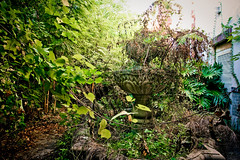Although the term “role-playing game” works well enough, players’ contributions in a good D&D game are not limited to playing the role of a particular character. They shape the plot, and, to varying degrees create the plot, choosing which objectives to pursue, or at least how. Relative to the referee, players’ contribution to setting is small, but it shouldn’t be non-existent.
For example, in the more recent Lesserton & Mor game, the party met a new PC named Isden. Because we met each other inside the ruins of Mor, it was a little awkward at first, with Isdn trying to hide in the shadows and Strothbogie poking him with a stick to see if he was real. So when the rats attacked, the rest of the party took refuge in the illusionary fire, and Isden fended for himself.
According to the referee, Isden was in a “ruined building.” Isden looked more closely and suggested that : (1) the roof might be intact (2) that there were holes in the roof that would allow access to someone inside and (3) that there would be some wooden support beams that he could use to climb up. I don’t know whether the referee rolled some dice or had to think about how these three ideas meshed with his own impressions of the setting. But it worked out ok for Isden and he got away from the rats. His player didn’t really create or change the setting, he just suggested details that seemed to fit with what he already knew.
Later, we returned to the task of cleaning the sacred fountain. The problem wasn’t stirges anymore; it was the plants growing in it that tried to strangle people. And again, we looked more closely at those ruined buildings. Was there a beam that could be removed safely, set on fire, and be thrust into the tangle of weeds? Yes. It didn’t work exactly according to our plan, but again players and referee collaborated over details that wouldn’t have seemed important to the referee while working alone.

No comments:
Post a Comment